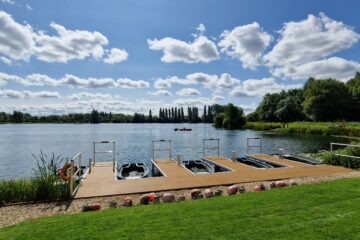
As a club, we are developing several strategies to help deal with problems relating to fish stress, warm weather and the accumulation of excess nutrients that can eventually lead to harmful algal blooms, especially during warmer periods. Our aim is provide a successful and attractive place to fish and a good environment in which the fish can thrive.
Most members will have noticed the aerators and many will be aware of the chalking that is carried out on an annual basis. Artificial aeration helps to maintain good dissolved oxygen levels, particularly in the summer months, and also helps move water around the lake during calmer weather to prevent stagnation. The purpose of the chalking is to promote the growth of microorganisms that break down silt and prevent it from becoming anaerobic, which would discourage aquatic plant growth, and, can lead to the production of gases (e.g. hydrogen sulphide) that are harmful to fish.
Encouraging and maintaining plant life also helps to maintain a healthy lake ecosystem. Marginal vegetation not only looks attractive, but is good for biodiversity by providing a good environment for invertebrates and other animals. Another key benefit of plant growth is that it helps to remove polluting nutrients such as phosphate and nitrate that will build up from the break down of waste products produced by the fish. By running a fishery, we are creating a fairly artificial environment by adding fish to the lake, so we need to regain a balance, and, by encouraging good plant growth, we are helping to do that.
Floating reed beds also remove these excess nutrients, but, in contrast to marginal plants, take nutrients directly from the lake water. They also provide benefits for fish and wildlife by providing additional and varied habitat for invertebrates and small coarse fish, both of which form part of the trout’s diet. During the Summer, the rafts should also provide shade and a slightly cooler environment to help fish survive.
On the subject of floating reed beds, you may have noticed a small, but significant recent addition to Darlow in the form of a prototype floating reed bed. The new design was conceived by Jim Thomas and assembled with some able-bodied help from a handful of committee members. Learning from the experience of the first two floating reed beds, Jim has developed these new ones to be less likely to inadvertently trap fish and less attractive to cormorants as a platform. The new design will also help protect the plants and help them get established more quickly. They have initially been planted up with native Darlow plants, so we are not introducing any new species to the lake. More photos of the floating reed rafts can be seen in the members area of the website.

The progress of the floating beds will be monitored to ensure that they are working as intended and not harming fish (or other wildlife) or encouraging increased predation, but we are hopeful that they will benefit Darlow in the long term as a natural way to remove unwanted nutrients, provide refuge and wildlife habitats.
Finally, and on behalf of the committee and club, our thanks goes out to Jim for his efforts in designing and building the reed rafts – we think they really look the part, and look forward to seeing a few more!


